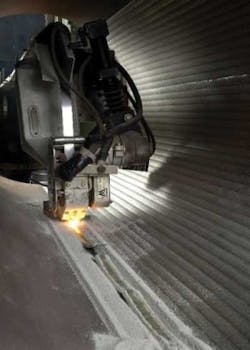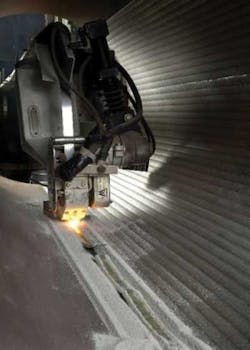Weld overlay cladding widens options in extreme subsea environments
Alan Robinson
Arc Energy Resources
With corrosion and corrosion prevention costing the subsea industry billions of dollars every year, the selection of materials to ensure the safe long-term operation of equipment such as pipelines and valves is vital, especially in deep sea operations.
Hydrogen sulfide (H2S), dissolved carbon dioxide (CO2) and various chlorides are all present in fossil fuels delivered from subsea fields. A sour service at high temperature is more corrosive, while the same service at high pressure is more erosive. A combination of the two is potentially hazardous and has serious implications on decisions such as whether to manufacture from high-cost corrosion resistant alloys, or to coat low-cost carbon steels using techniques such as weld overlay cladding.
Where maximum protection is needed, corrosion-resistant alloys (CRAs), including austenitic and ferritic/martensitic stainless steels, duplex stainless steels or the more complex high nickel chromium alloys, must be considered. Duplex steels and nickel-based alloys such as alloy 625 are the only materials which, when welded, will achieve the levels of strength to match carbon steels. However, there are constraints on their use in solid form – namely high cost, availability and the need for highly controlled welding procedures.
Alternatively, weld overlay cladding of carbon steel offers a wide choice of processes and flexibility to protect an almost infinite range of component shapes and sizes, with an equally wide range of base materials and cladding alloys.
A recent example that demonstrates this point was the decision of Subsea Riser Products (SRP) to specify weld overlay cladding to protect more than eighty 24-in. (61-cm), heavy-walled flanges, each weighing 1.6 metric tons (1.76 tons), and various stress and tension joints up to 9 m (29.5 ft) long and weighing up to 10 mt (11 t). Arc Energy Resources won the cladding contract for both programs.
5k drill riser.
The components, which are used on high-pressure drilling risers destined for projects in the UK and Norwegian sectors of the North Sea, provide the vertical pipe connection between the seabed and host vessel in drilling, production or completion environments.
According to SRP, the company’s flange couplings are designed to provide long-term structural integrity and sealing in extreme load and pressure applications. Weld overlay cladding is vital for the riser couplings to achieve reliable pressure containment in a corrosive environment. One of the company’s risers destined for the UK sector is designed for a working pressure of 10,000 psi (689 bar) with an extreme peak pressure rating of 12,200 psi (841 bar), which will make this one of the highest-pressure drilling risers currently operating in the North Sea.
The majority of the components clad by Arc Energy were 21-in. (53-cm) diameter pipe connections with flange outside diameters of 1.1 m (3.6 ft), manufactured from high-strength, low-alloy steel. First, the specially designed cladding stations applied a corrosion-resistant 625 Nickel alloy to the flange sealing pockets. Cladding the two upper and three lower tapered stress joints, and the three tension joints, proved more challenging due to the physical size of the components (length up to 9 m, weight of 10 metric tons). In addition, cladding SRP’s flanges and integrally formed components required new welding techniques to be qualified, and the size of the stress joints demanded specialized handling equipment to allow them to be manipulated.
Finally, a caveat: the development of today’s cladding technology is so tightly defined that it is essential to maintain ISO 3834-2 (Comprehensive Quality Requirements for Fusion Welding of Metallic Materials) and employ the services of a European Welding Engineer.
Arc Energy offers a wide range of base metal/cladding combinations is also qualified to ASME IX, API 6A and NACE. In addition, the manufacturing infrastructure is qualified to BS ISO9001:2000 and ISO3834-2. Arc Energy also offers in-house test weld, heat treatment and NDT facilities.
Fifteen workstations equipped with the latest advanced control and inspection facilities are able to clad components up to twelve tonnes, even in areas of restricted access within bores as small as 50 mm (1.97 in.) diameter and up to four meters (approx. 13 ft). Typical applications include pressure vessels, oil and gas industry equipment, subsea piping, and wellhead equipment.
Offshore Articles Archives
View Oil and Gas Articles on PennEnergy.com





